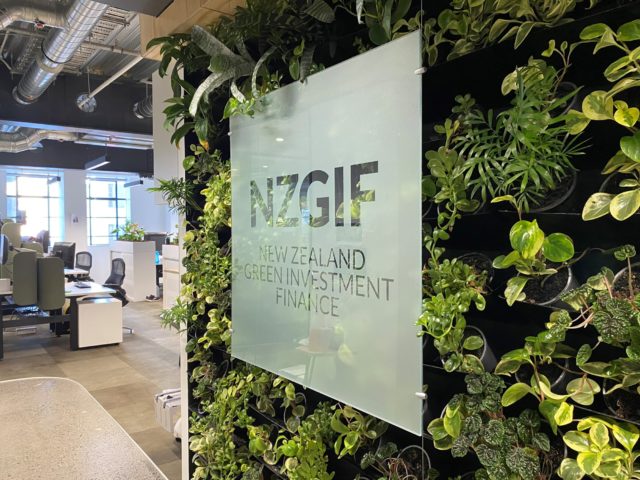Case study
New Zealand Green Investment Finance

New Zealand Green Investment Finance (NZGIF) is a green investment bank established by the New Zealand Government in April 2019 to accelerate investment to reduce greenhouse gas (GHG) emissions in Aotearoa New Zealand. As a purpose-driven investor we use innovative and flexible capital solutions to invest in scalable companies, technologies and projects, and work to crowd-in private finance in the market.
NZGIF has begun using climate conscious legal drafting to ensure our contracts support our mandate to reduce emissions and accelerate Aotearoa New Zealand’s transition to a low carbon economy.
NZGIF’s involvement with The Chancery Lane Project (TCLP) was born out of our market demonstration function. We aim to demonstrate to the market that legal frameworks can enable and encourage businesses and communities to have a positive impact on the environment. Making our contracts as climate friendly as possible is a natural way to extend the emissions benefits that can be achieved through the investments we make.
What do The Chancery Lane Project’s clauses deliver for NZGIF?
Our aim is to integrate appropriate TCLP climate clauses into all our contracts where suitable. Our challenge was to right-size TCLP climate clauses for our use, given the market is primarily made up of small and medium enterprises (SMEs), which means comparatively smaller transaction sizes.
We have developed our own bank of adapted TCLP climate clauses that can be used in different circumstances, including:
- Toby’s Clause: avoiding excessive paperwork in dispute resolution.
- An electronic notices clause (similar to that in Callum and Theo’s Clause).
- Kaia’s Clause: climate-purposed NDA terms.
- Lauren’s Clause: green shareholders’ agreement (which we have adapted into a long-form and short-form version).
- Annie’s Clause: green termination provision for a customer.
- Teddy’s Clause: supplier environmental threshold obligations.
- Zain’s Clause: carbon footprint reduction notice.
We have developed our own light-touch clause for inclusion in a shareholders’ agreement where Lauren’s clause might be too onerous (for example, in a start-up context). That clause encourages the shareholders to work together in good faith with a view to achieving net zero. It stops short, however, of imposing measurement or reporting obligations, which are likely to be too great a challenge for small businesses.
We have used TCLP climate clauses in our suite of lending documents (both loan and security documents) and in our equity investment documents (including a subscription agreement, shareholders’ agreement and pro-forma constitution). Where external legal counsel document our transactions for us, we incorporate relevant TCLP climate clauses into their documents too. We hope this will encourage the finance sector to use climate clauses so that climate contracting becomes the norm in Aotearoa New Zealand.
After identifying the clauses appropriate to us, we adapted them to fit our context. In some cases, we needed to create several versions of the same clause with varying levels of obligation (seeing as TCLP climate clauses are not yet widely used in Aotearoa New Zealand). We tested the clauses on a transaction where the sustainability aims of the parties were front and centre. Having seen how receptive parties were to those, we began a wider rollout, which included a presentation to all our staff about TCLP climate clauses and how we plan to use them.
“TCLP’s climate clauses have helped us appreciate the broader impact our contracts can have in the transition to Net Zero. TCLP has also catalysed discussions with, and extended our ability to influence, participants in our financial markets.”
What is the impact of using climate clauses in these contracts?
TCLP’s clauses are particularly valuable in the context of financing more sustainable business. It is important to consider all scopes of emissions; this includes those relating to operations as well as the emissions associated with the project being financed. TCLP climate clauses also address other issues such as the impact of that financing on the transition to net zero.
We are always considering how our documents can drive even greater impact. We work with our investee companies to help them implement these clauses in their businesses. We’re also conscious of our ability to drive better outcomes from our suppliers through contractual obligations focused on sustainability.
What are your next steps for using climate clauses?
We plan to continue to roll out TCLP climate clauses in our contracts. This includes the clauses we already use and any other clauses that may be relevant.
As one of the first adopters of TCLP climate clauses in Aotearoa New Zealand, we know that most of the clauses will require amendment for our domestic context and need to be pitched at the right level of engagement. We expect that the level of ambition applied to TCLP climate clauses will increase as they become more prevalent in our domestic market.
Our journey with TCLP climate clauses is in its infancy, but we are excited about the part they could play in our work to accelerate private and public investment in emissions reductions in Aotearoa New Zealand.
Key takeaways
- TCLP climate clauses can be adapted for international jurisdictions and other sectors such as SMEs.
- TCLP’s climate clauses are not a source of protracted negotiation in contracts. Our experience is that parties are generally very receptive to them.
- When starting out with TCLP climate clauses, it is important to identify the clauses that will work for your business and adapt them to do that. TCLP has a huge database of clauses, but not all will be relevant to your practice area or sector.
- Getting engagement at a senior level within your organisation is helpful to a smooth rollout of TCLP clauses. However, as important is getting staff engaged with the clauses and the difference they can make (particularly where staff will need to push for their inclusion in contracts, for example, where contracts are drafted by third parties).
For more climate contracting resources like this, join us here.
Are you using our clauses?
We’d love to hear how you’ve implemented our clauses in your organisation.